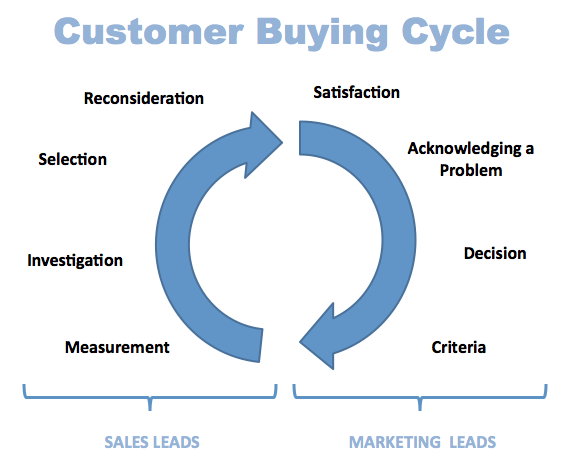by Glen Springer | Apr 1, 2013
 Marketers in nearly all industries are calling 2013 the ‘Year of the Customer’. This insight reflects the fact that in recent years, the sales cycle for B2B companies has shifted to focus much more on consumer demand. Developments in technologies and the globalization of business have created a world where marketers need to meet their prospects and customers on their own level, when and where the customer choses.
Marketers in nearly all industries are calling 2013 the ‘Year of the Customer’. This insight reflects the fact that in recent years, the sales cycle for B2B companies has shifted to focus much more on consumer demand. Developments in technologies and the globalization of business have created a world where marketers need to meet their prospects and customers on their own level, when and where the customer choses.
Customers now want to be treated like individuals with individual needs and desires. For marketers, this means providing individualized marketing content based on each prospect’s preferences and habits. Without marketing automation, this task can be daunting for B2B companies trying to reach hundreds or even thousands of prospects. When leveraged properly through a well-designed content marketing strategy based on buyer insights, a marketing automation solution can severely decrease the workload required for both B2B marketing and sales teams by reaching hundreds of prospects with a few clicks.
There are nearly endless pieces of the B2B sales and marketing process that can be automated with marketing automation. Here are 3 things that B2B marketers should always automate that will drive revenue while simultaneously decreasing the sales effort required to close:
- Customer/Prospect Data. In terms of new prospects, marketing automation is a great way to start a relationship while exerting very little effort. By creating and automating an email “Welcome Campaign,” you can offer basic information about the business problems you solve and request more information regarding prospects’ needs. You can also use marketing automation to maintain your existing customer relationships by asking them to update their information with any recent changes, which may present you with new opportunities to upsell.
- Reviews & Testimonials. Reviews of your product or service by your existing customers have tremendous value in the new, customer-centric sales cycle. Using marketing automation, you can solicit these reviews and then turn them into marketing content in the future. In addition to requesting reviews or testimonials of your product or service, you can ask reviews of the marketing content your prospects engage in as they move through the nurturing process. This will allow you to give your prospects more incentive to engage in your content (e.g. “This whitepaper was extremely insightful on industry changes and offered amazing tips for generating demand!”–John Smith, CEO) while also giving you feedback on how to improve your own marketing strategies.
- Events. Events are becoming more and more popular in B2B sales and marketing. Digital events like webinars and live demos are a great way to generate new leads and educate and nurture prospects. You can use marketing automation to send out many different types of messages related to an event, depending on a prospect’s behavior. After the initial invitation, you can automate different responses based on if the invitation was opened or if the prospect registered for the event. You can also automate “thank you for attending” emails containing new marketing content to prospects who actually attended your event while sending “sorry we missed you” emails offering recorded versions of the event to no-shows.
Marketing automation has the potential to take all (or at least most) of the guesswork out of the B2B sales cycle. Using marketing automation, you can gather customer insights at the same time you nurture prospects and close deals. Marketing automation puts the information you need to sell at your fingertips, as long as you know what to do with it.
If you would like to know more about how marketing automation helps B2B companies streamline their sales and marketing efforts into one easy-to-manage process, please feel free to contact us.
by Glen Springer | Dec 11, 2012
 Once you’ve kicked off an initial marketing automation software implementation, ongoing maintenance and management are key to getting the most out of this resource. Here are 9 ways to optimize your marketing automation software once you’ve gone live (and a bonus file at the end):
Once you’ve kicked off an initial marketing automation software implementation, ongoing maintenance and management are key to getting the most out of this resource. Here are 9 ways to optimize your marketing automation software once you’ve gone live (and a bonus file at the end):
1) Review the commonly consumed content by people who convert to buyers, assigning higher value scores to prospects when that content is consumed. Further, consider building it into an automated drip campaign, especially if there is a consistent sequence of content consumed by your buyers.
2) Analyze drip campaign stages for high metric-based performance e.g. CTR or unsubscribe rate and adjust your campaigns accordingly. If there is a piece of content that people commonly unsubscribe from, remove it immediately. If there is a email that has a high CTR, optimize the respective landing page.
3) Monitor and disable inactive automation rules. Outdated automation rules may be conflicting with how you want your software to function. Be sure you are doing a schedule maintenance on automation rule behaviors and removing ones that no longer serve you.
4) Confirm that new prospect notification rules take in account when there is newly published forms/landing pages and when new people on team that require notifications. Having instant notification go to the required parties is essential to getting the most out of your tool.
5) Assuming you have the Google Analytics connector enabled, be sure that the campaign URL builder is filled out for all respective content and custom redirects, allowing you another analytic view of content consumption and visitor behavior.
6) Build a testing protocol for quality control. Example items to QC are: emails include dynamic field insertion, forms work and submission notifies respective parties, landing pages are checked for spelling, grammar and working links, page actions are properly being applied, automation rules work properly, etc.. Create an internal list of test users and a test plan template.
7) Implement dynamic segmentation liberally for highly targeted campaigns and ease of suppression. Examples include:
- segmenting users by location (city, state, zip) so that targeted messages can be sent if you are going to be visiting an area
- segmenting by industry/vertical for customized content
8) Use embedded personalization to deliver the highest targeted website and email messages. This can be complex, but here is a step-by-step example:
- Create a rule that applies a tag called “whitepaper_request” to a prospect who submits a form for a download request
- Design a personalization script that looks for that tag on an existing cookied prospect and replace that whitepaper download call-to-action with an alternative call-to-action. Note: in the personalization design, the default will need to be the original whitepaper call-to-action code.
- Insert the code provided from the personalization script and replace it on your site where the current static whitepaper call to action resides.
9) Create a shared implementation map/checklist and historical change document. Consider using something like Google Docs, with a form and spreadsheet integration so that each change will be entered into a form and tracked in the corresponding spreadsheet, allowing all of the necessary change details to be documented.
Request an Excel download for a basic implementation checklist with status tracking:
by Glen Springer | Nov 23, 2012
 B2B marketing is changing dramatically and it’s going to take an even greater commitment by marketers to embrace and execute effective B2B marketing. Here are the top ten things I believe you need to commit to in 2013 to be part of the transformation B2B marketing is going through.
B2B marketing is changing dramatically and it’s going to take an even greater commitment by marketers to embrace and execute effective B2B marketing. Here are the top ten things I believe you need to commit to in 2013 to be part of the transformation B2B marketing is going through.
1) Commit to multimedia content marketing that truly educates your potential buyers. You want the content to be so strong that your prospects have full-heartedly believe that they are more intelligent around the topics presented in your content than they were before they consumed it. You want it to be diverse in type (video, eBooks, blog posts, webinars, etc.) because people learn differently (and search engines will reward you for the diversified content types).
2) Develop and adhere to a content publishing schedule. This is important for a few key reasons: 1) keeping all responsible parties on track regarding the content creation and publishing cycle 2) establishing a pattern with your audience so they confidently expect new education on a regular basis 3) the ability to batch produce, plan ahead and pre-schedule posting so that when the inevitable interruption deters you, you have a backup plan to get the content out on time anyway.
3) A greater commitment to search engine optimization. The foundations of SEO are in flux with the current state and changes in social media, content marketing, vertical search, continuous search algorithm changes, and more. We believe a full-time commitment to SEO is necessary for all B2B marketing campaign portfolios. It often produces the strongest leads and, when done correctly, has longer lasting passive lead generation benefits that other B2B marketing campaigns.
4) Develop a social media marketing plan. B2B Marketers need to develop and execute an actual social media plan with functions in place to measure the social media ROI. This plan should at least include the use of Facebook, Twitter, Google+, LinkedIn and other social forums that have an industry-related focus.
5) Dig deeper into your web/data analytics goldmine. First, make sure your analytics data is well organized in some type of central reporting area/dashboard. Secondly, establish regular review periods to assess current performance across your KPIs against historical benchmarks. Third, set up instant alerts that notify you of key opportunities or concerns.
6) Implement marketing automation software. 2012 was my maiden voyage into the world of b2b marketing automation software. On the consumer marketing side, I’ve used some tools that do some components of marketing automation, but nothing like what I’ve seen done in the past 6 months. Tools like Pardot, Marketo, Eloqua and a few others are changing the B2B marketing game big time, yet the adoption rate is is still low enough to where you can gain some true competitive advantages if you implement in a timely manner. There are more than a dozen recommended marketing automation strategies that I can think of. Look for an additional blog post on this, but in the mean time read this blog post on how marketing automation helps sales teams.
7) Optimize your landing pages. You are likely sending people to various landing pages through your different marketing channels. Additionally, there are organic landing pages that reveal themselves over time (using Google Analytics data). This is often your best chance to get someone engaged with your company – make it count. There are countless resources for “landing page optimization” some with opposing views, so my number one tip for landing page optimization is make sure you split test.
8) Improve your website’s user experience. Some examples of ways to do this include: 1) Improve your page load time. Page load time is a positive or negative user experience. A fast load time gets potential prospects to your content/message faster. Slow load time keeps your prospects waiting or worse, going elsewhere. People doing research want information fast. If your site doesn’t load swiftly, you are likely losing leads. 2) Consistent and easy to use navigation. You want users to be regular visitors to your site (either for purchases or continued trust building with your site as an authoritative hub). Good navigation helps your users get to where they need to go with ease. This also includes a good internal search engine. 3) Make it easy for them to take the most desired action on each respective page they are visiting, e.g. when offering a free whitepaper, make it abundantly clear what they need to provide and how exactly the whitepaper will be delivered.
9) Create a greater mobile experience for your websites. Whether its a responsive website re-design or delivering a mobile-based theme through device detection, more and more people are using mobile devices to consume content. Personally, I keep my laptop put away late at night and use my mobile devices to do research, solve business problems and to keep communication flowing (e.g. late night email, instant messaging, texting).
10) Get more involved in the lead nurturing and sales education process. Other experts I know in this space are predicting a much greater role to be played by marketers in strengthening demand generation, lead nurturing, and using targeted content marketing for sales education (moving away from just focusing on top funnel lead generation volume). B2B marketers should expect to be more deeply involved in the prospect buying cycle. This will require a more active participation with the sales team, product experts, and, most importantly, prospects themselves.
B2B marketing requires a new breed of marketers – people who are: knowledgeable/experienced in B2B selling, technically skilled, analytical, organized, productive, and business-savvy individuals who work well across teams to champion the creation of high performing, measurable, and predictable lead/demand generation and sales conversion systems.
Now, imagine the workload and personnel commitment required to make all that happen within a single company. First, you need at least one person to get up to speed on the changing tools, technologies, language and strategies required for the new rules of B2B marketing. Then, not only do you need that individual or team to learn all of this, you need them to be able to articulate it clearly across teams so that everyone understands and is on board with the changing rules and processes. Next, you need a diehard commitment to actually managing, implementing and optimizing all the different projects that come about by committing to the 10 issues above. Projects like website redesign, new software implementation, consistent content production, streamlining reporting/analysis, and more are huge undertakings.
At Gabriel Sales, we have:
- gone through the learning curves
- championed the transformation into various companies
- stayed abreast of B2B marketing best practices
- deployed the projects required to meet our B2B marketing recommendations
- continued to hone and optimize our own strategies as well as our clients
Working with an outsourced B2b marketing firm like Gabriel Sales will help you deploy these recommendations more quickly and cost-effectively compared to doing all of the work in-house. If you’d like to learn more about how we would help you, please request a complimentary review here.
 Marketers in nearly all industries are calling 2013 the ‘Year of the Customer’. This insight reflects the fact that in recent years, the sales cycle for B2B companies has shifted to focus much more on consumer demand. Developments in technologies and the globalization of business have created a world where marketers need to meet their prospects and customers on their own level, when and where the customer choses.
Marketers in nearly all industries are calling 2013 the ‘Year of the Customer’. This insight reflects the fact that in recent years, the sales cycle for B2B companies has shifted to focus much more on consumer demand. Developments in technologies and the globalization of business have created a world where marketers need to meet their prospects and customers on their own level, when and where the customer choses.
 Many B2B companies try so hard to generate more leads that they do not come up with a clear strategy for how to do so most efficiently and effectively. What these companies do not understand is that a successful campaign requires clearly defined goals and a well-articulated strategy.
Many B2B companies try so hard to generate more leads that they do not come up with a clear strategy for how to do so most efficiently and effectively. What these companies do not understand is that a successful campaign requires clearly defined goals and a well-articulated strategy. Once you’ve kicked off an initial marketing automation software implementation, ongoing maintenance and management are key to getting the most out of this resource. Here are 9 ways to optimize your marketing automation software once you’ve gone live (and a bonus file at the end):
Once you’ve kicked off an initial marketing automation software implementation, ongoing maintenance and management are key to getting the most out of this resource. Here are 9 ways to optimize your marketing automation software once you’ve gone live (and a bonus file at the end):
 B2B marketing is changing dramatically and it’s going to take an even greater commitment by marketers to embrace and execute effective B2B marketing. Here are the top ten things I believe you need to commit to in 2013 to be part of the transformation B2B marketing is going through.
B2B marketing is changing dramatically and it’s going to take an even greater commitment by marketers to embrace and execute effective B2B marketing. Here are the top ten things I believe you need to commit to in 2013 to be part of the transformation B2B marketing is going through.